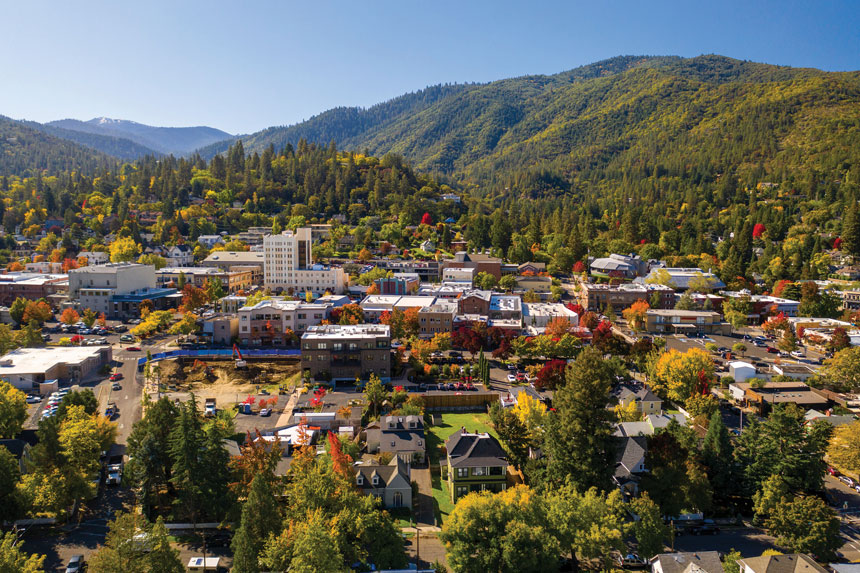This country is littered with dying small towns that lacked a plan B, one they should have had in place before the mill shut down or the factory moved to Mexico.
Mount Shasta, California, and Ashland, Oregon, did it right. Located in the California-Oregon border region where I live, they avoided economic devastation by having their survival plans well underway by the time their lumber mills began to shut down more than a half-century ago.
Indeed, Mount Shasta was more than 100 years ahead of the curve thanks to a guy named Justin Hinckley Sisson, who planted the seeds for the town’s future reinvention as a recreational tourist destination. A schoolteacher from Connecticut, Sisson moved out West and reinvented himself as a rugged outdoorsman. In 1866 he opened a hotel and restaurant on the lower slopes of Mount Shasta and started taking his visitors on hunting, fishing, and mountain-climbing excursions.
The timber boom that had begun around that time had pretty well petered out by 1990, when the last lumber mill closed in Mount Shasta.
By then, a wave of newcomers attracted to the recreational opportunities in the area had taken up where Sisson left off, setting up outfitting stores and offering guide services. A new ski park opened in 1985. All this was complemented by a new batch of motels and restaurants. Beginning in the late 1990s, a nonprofit organization called the Mount Shasta Trail Association, fueled by grants and private donations, greatly expanded the area’s hiking opportunities, adding 20 miles of trails along lakes and rivers and on the slopes of Mount Shasta, with another 46 miles currently in the works. All in all, it added up to a smooth and vigorous transition from a timber-based economy to one based on recreational tourism.
Seventy-five miles up the road sits another former timber town, Ashland, Oregon. The last of its eight lumber mills shut down in 1967. But an English professor at the local college, Angus L. Bowmer, had already planted the seeds for the town’s reinvention. Bowmer had done some amateur acting on the side, and he got the idea of converting an unused structure in the city park into a venue for Shakespearean plays. The city of Ashland offered him $400 and funds for a construction crew — just enough support to get his project off the ground.
The first two productions occurred in 1935 and became an annual event: the Oregon Shakespeare Festival. By the 1960s, the festival had established Ashland as a major theater town that drew fans of the Bard from up and down the West Coast. By 2019 the Ashland Chamber of Commerce estimated that over 100,000 visitors were showing up at the theater festival each season. Its success has spawned a number of other live theater venues.
What do these two successful town reinventions have in common? They both carry the promise that visitors to the town will leave their drab, boring lives behind and find something new and exciting.
A successful reinvention is a high tide that raises all boats and attracts that surge of hikers and skiers and theater-goers who fill the hotels and restaurants and keep the cash registers in the retail shops humming.
But what happens when the tide doesn’t roll in?
The small town where I live — Dunsmuir, California — provides an example of what happens when you don’t have a plan B. Dunsmuir is just 10 miles down the road from Mount Shasta. In its heyday, Dunsmuir was a thriving railroad hub for passenger trains, equipment repair, and crew changes. Ten passenger trains came through every day, but now most of that has gone away. It’s down to two passenger trains each day, and freight train crews are less than half what they were in the days of steam locomotives.
There was no plan B in place before, or during, the railroad’s decline. So now, more than half a century later, well-intentioned people here are playing catch-up, trying to bring the town back to life, but through piecemeal efforts: a new art gallery, a small performing space, a microbrewery, some pretty good restaurants.
None of this adds up to a solid rebranding. The town has shrunk from 2,200 in population when I moved here 27 years ago to 1,700 today. This is despite a number of elements in Dunsmuir’s favor: the Sacramento River runs right through it. It’s considered one of the best flyfishing destinations in California. Hiking trails abound, and the slopes of Mount Shasta and the ski park are a short drive away.
But new enterprises tend to come and go at a high turnover rate, like the outfitting store that only lasted a couple of months. An entrepreneur from Oakland, who’d made a bundle selling novelty items in China, bought up a half-dozen downtown properties 20 years ago and promised that it would be the beginning of the town’s revival. Those buildings still sit empty. It’s tough to get a plan B going in a depressed economy.
In their book, Our Towns, the journalists James and Deborah Fallows found common factors in successfully reinvented towns across the United States. Among them was an openness to newcomers, to new people bringing new talents and ideas to their new homes. In these open towns the newcomers often find opportunities to reinvent themselves, to apply whatever skills and talents they may have in new ways in this new, stimulating environment. The retired accountant who made his own beer at home opens a microbrewery. Or the English professor gets into the theater business. Or that Connecticut schoolteacher opens a hotel and starts taking his visitors on hunting and fishing excursions.
In Dunsmuir we see similar personal transformations that could plant the seeds for a successful town reinvention: A former stock and bond trader from the Bay Area took over the flyfishing shop. A former bank executive from San Francisco runs the hardware store.
Every small town has its share of talented, enterprising folks, the ones who get the art galleries and the microbreweries going. But they can’t do it alone. They need visitors and ideas from elsewhere. And people need to direct their positive energy and talent in the same direction, and come up with a theme, a story for their town to tell. Otherwise, they’re likely to have a nice, quiet town with a lot of empty storefronts.
Tim Holt is the editor of the quarterly Northwest Review and the author of the back-to-the-land novel On Higher Ground, set in the Mount Shasta region.
This article originally appeared at Zocalo Public Square (zocalopublicsquare.org)
This article is featured in the March/April 2024 issue of The Saturday Evening Post. Subscribe to the magazine for more art, inspiring stories, fiction, humor, and features from our archives.
Become a Saturday Evening Post member and enjoy unlimited access. Subscribe now




Comments
Tim Holt’s article, “Small towns Need a Plan B” was of special interest to me as a retired Urban Planner. He focuses heavily on the idea that people from outside bring in new ideas that can generate the reinvention that the town needs and suggests that individuals can make all the difference. This is true to an extent, but my experience has been that change happens primarily through collaboration among business owners and residents who live in the town. Without their buy in, new efforts often fail. The community should consider working with the California Main Street Program. This group helps small towns organize, promote, design and increase economic vitality by assisting local volunteers and a main street manager. This is based on a national model, especially designed for historic small towns. I used it successfully in my small town in northern Maryland.
Dunmuir has so much going for it and can capitalize on its natural resources, its history, the railroad, gold rush and the Scottish origins, but it needs to be a joint effort with current citizen, government and business support. The Main Street model is designed to assist local communities build the network needed to identify and implement “Plan B”.
I believe this article was about forward thinking to survive economic insecurity when businesses close or economics change. Some responses were about “migrant/immigrant crisis”. I can’t be silent about ILLEGAL migration & how breaking our laws to get here will NOT help anyone in any town. We are all grateful for LEGAL immigrants and welcome those who take allegiance to America AND our small towns.
So someone writes a positive editorial about how towns can reinvent themselves with “new” ideas and “new” people, and someone has to turn this into a rant against immigrants (who btw, bring “new” ideas, “new” people and also new skills and new capital. And somehow it is only “conservative” leadership that can make another town better by removing traffic lights (probably didn’t want to pay for their maintenance) but if it helped, it helped. But my point is, this article talks about art galleries (oh my, subversive artists) and microbreweries not being enough. It needs “new” energy. And guess where much of that “new” energy comes from? Immigrants, migrants, those from the north and those from the south. And the east and west. Please, please give up your xenophobia. People are people and they want nice towns and nice businesses and nice houses, just like everyone else. And migrants/immigrants are some of the hardest working people out there.
Conservative leadership with forward-thinking, outside-the-box ideas who encourage other like-minded entrepenures who have a vested interest and love for their hometown to invest in the revitalization of downtown venues and businesses are key. Two such towns in two of the smaller counties in Tennessee are Pikeville (County Seat of Bledsoe County) and Dunlap (County Seat of Sequatchie County). Pikeville eliminated all traffic lights through town replacing with four way stops in a very neat, clean downtown district after a bypass was completed of US 127 around town. It is beautiful with all the small shops all around and the historic Bledsoe County Courthouse is the perfect staple. They received a grant to assist in the beautification of the town. To a lesser degree Dunlap, located 20 miles south from Pikeville on US 127 has done the same. Yet, they are still working to make it more attractive. The drawback to Dunlap is the constant traffic going through the the middle of town on US 127 because they not as yet fortunate as Pikeville with a bypass to move traffic around. Perhaps they’ll get on it some day. In any case, if you are in the area of the upper Sequatchie Valley of central Tennessee, I would encourage you to visit Pikeville or Dunlap. I think you will be pleasantly impressed.
It’s hard to know what to do now Tim, with the migrant/immigrant crisis getting worse by the day; not only from the southern border, but the northern one (largely being ignored) as well.